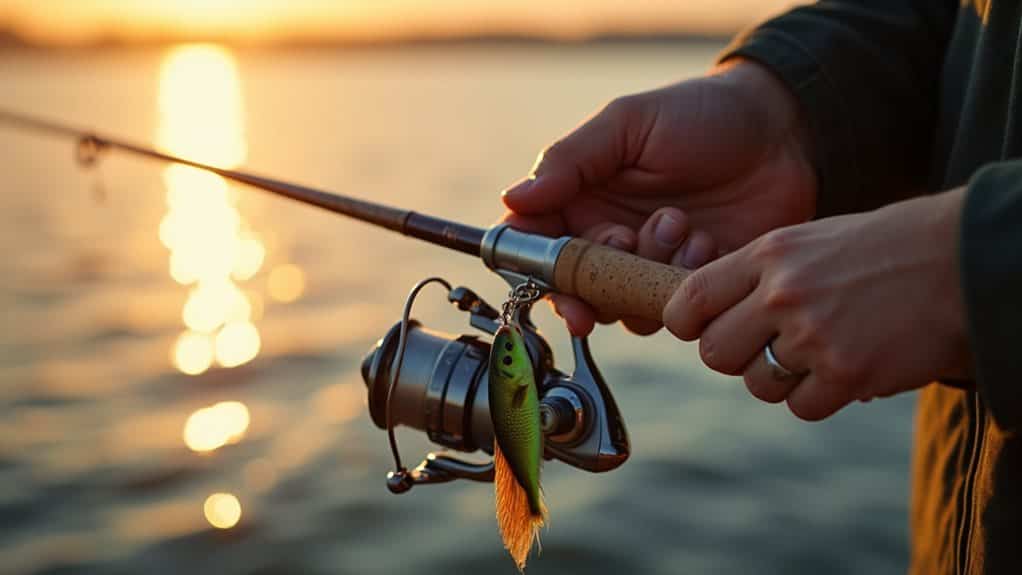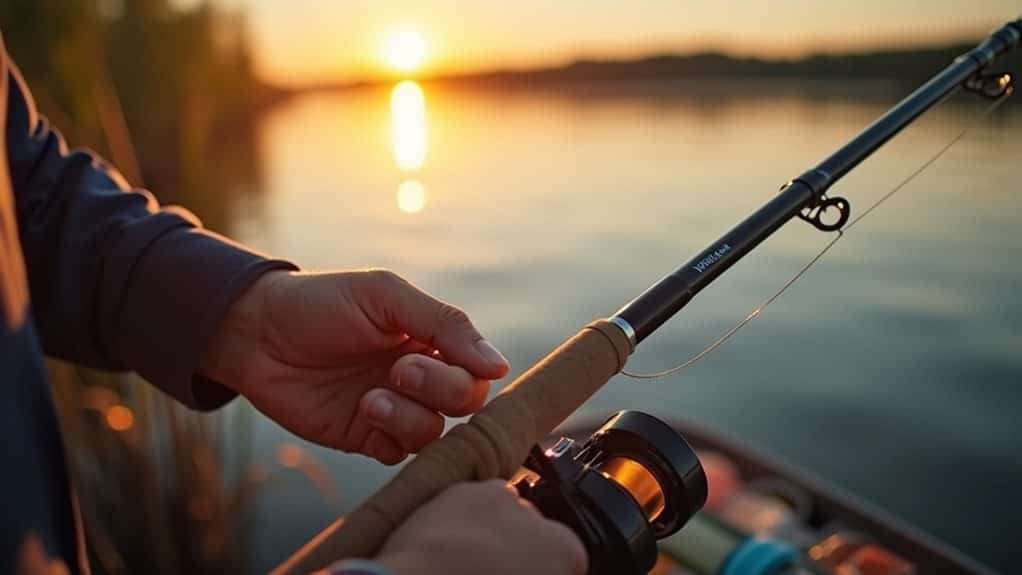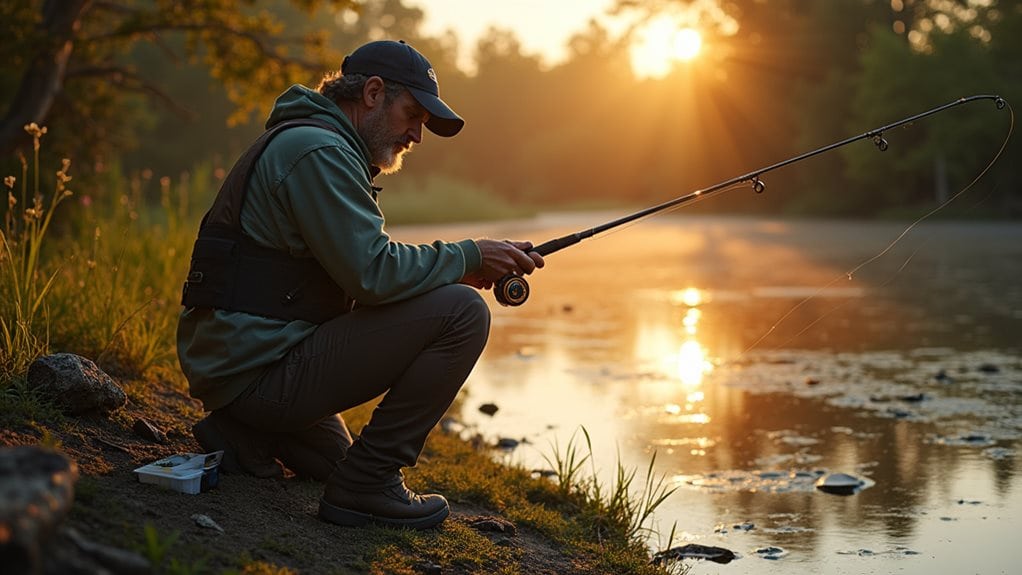Start by matching your rod to the conditions—choose a 7-foot medium or medium-heavy with fast action for versatility, then pair it with a spinning reel for finesse work or a baitcaster for power fishing. Spool your reel with line suited to your environment: fluorocarbon for clear water, 30–40 lb braid for heavy cover, or mono for topwater. Assemble by aligning rod guides along the spine, securing the reel foot firmly, and filling the spool to within 1/8-inch of the rim. Command the Palomar knot and rig selection—Texas for vegetation, drop shot for suspended bass—to maximize your success across different scenarios.
TLDR
- Match a 7-foot medium rod with appropriate reel: spinning reels for finesse, baitcasting reels for power fishing and accuracy.
- Spool fluorocarbon for clear water, braid for heavy cover, or monofilament for topwater while maintaining moderate tension.
- Align rod guides along the spine, insert reel foot into seat, and tighten securely without over-tightening.
- Fill spool to within 1/8-inch of rim to prevent tangles and ensure smooth casts with proper line flow.
- Tie a Palomar knot for strong connections with all line types when rigging hooks and terminal tackle.
Selecting the Right Rod Length and Action for Bass Techniques

When you’re setting up a fishing pole for bass, selecting the right rod length and action forms the foundation of your entire setup.
A 7-foot medium rod offers versatility for most scenarios, balancing casting distance with accuracy.
Shorter 6’6″ rods excel in tight cover, while longer options over 7 feet provide advantage for crankbaits and extended casts, making your technique selection essential for success.
Medium rods handle a broad range of lines from monofilament to braided, adapting to different fishing conditions and personal preferences.
Also consider rod material—graphite and fiberglass rods offer different sensitivity and durability characteristics that affect performance.
Choosing Between Spinning and Baitcasting Reel Setups
Narrowing down your reel choice between spinning and baitcasting setups represents one of the most critical decisions you’ll make when rigging for bass.
Spinning reels excel with lighter lines and finesse presentations, offering easier operation for beginners and longer casts with small lures.
Baitcasters provide superior accuracy and control with heavier baits, making them ideal for power fishing techniques and extracting bass from thick cover.
Proficiency with both types is recommended, as top anglers continue to use spinning rods effectively alongside baitcasting gear.
Many kayak anglers also pair their reel choice with an appropriate fish finder to improve catch rates by locating bass and structure more efficiently, especially using CHIRP sonar for better fish detection.
Matching Line Type and Strength to Your Fishing Conditions

Selecting the right line type and strength for your bass fishing setup dramatically affects your success on the water, as each line material brings distinct advantages that match specific conditions and techniques.
Fluorocarbon’s near-invisibility makes it ideal for clear water and finesse presentations, while braid’s zero stretch and high strength excel in heavy cover and topwater applications. Monofilament’s stretch benefits topwater techniques, providing forgiveness during strikes and keeping lures floating naturally. Many anglers also pair their line choice with the appropriate electronics, like a CHIRP transducer, to locate structure and fish-holding areas more efficiently.
Properly Assembling Your Rod and Reel Components
Once you’ve selected your line, the next critical step is assembling your rod and reel correctly to guarantee reliable performance on the water. This process involves three key components: aligning your rod’s guide system so line flows smoothly during casts, securing your reel firmly to the rod seat to prevent any movement during fights with bass, and properly loading line onto the spool with correct tension.
Getting these fundamentals right from the start will prevent frustrating equipment failures and help you focus on what matters most—landing fish. Proper kayak fishing setup also includes essential accessories like a comfortable PFD for safety and storage solutions to keep gear secure, which will improve your overall experience on the water and reduce risks associated with extended trips; consider adding a Personal floatation device to your checklist.
Aligning Rod Guide System
Proper guide alignment converts an ordinary rod setup into a precision casting instrument, directly influencing your accuracy, distance, and overall fishing success.
Align guides precisely along the rod’s spine to prevent line tangles and blank twist.
Check alignment by sighting down the rod’s length, ensuring all guides form a straight line.
Proper spacing reduces friction, protects your line, and maximizes casting performance for bass fishing techniques.
Securing Reel to Rod
With your guides perfectly aligned, the next step brings your rod to life by mounting the reel that’ll control your line and land those bass. Insert the reel foot into the seat’s slot, then tighten the locking mechanism until secure—but don’t overdo it.
Check that the reel sits centered and straight, with no wobble when you rotate the handle, ensuring peak casting performance.
Loading Line on Spool
Threading line onto your spool marks the point where your rod and reel metamorphose from separate components into a functional fishing system, but loading it incorrectly can lead to frustrating tangles, lost fish, and wasted money.
You’ll want to maintain moderate tension throughout spooling, using finger pressure to keep the line snug while filling to within 1/8-inch of the spool rim for peak casting performance.
Essential Knots and Rigging Methods for Bass Fishing
To maximize your success in bass fishing, you’ll need to master a few fundamental knots and rigging techniques that directly impact your hookup ratio and bait presentation. The Palomar knot stands out as your go-to connection for its exceptional strength with braided line, while the drop shot and Carolina rigs offer distinct advantages for different water conditions and bass behavior.
Let’s break down each technique so you can confidently tie these knots streamside and assemble rigs that’ll put more fish in your boat.
Mastering the Palomar Knot
Learning the Palomar knot will convert your bass fishing setup from vulnerable to virtually bulletproof.
You’ll pass doubled line through the hook eye, tie an overhand knot, then slip the loop over your lure.
This double-line connection maintains exceptional strength with monofilament, fluorocarbon, and braided lines.
Moisten before tightening to prevent friction damage, and you’ve created one of fishing’s most reliable connections.
Drop Shot Rigging Tips
When bass refuse to commit to aggressive presentations, the drop shot rig becomes your secret weapon for triggering bites from finicky fish.
Tie your hook using a Palomar knot, leaving 6–24 inches of tag end for the leader.
Attach a 1/8 to 1/4 ounce tungsten weight at the bottom, nose-hook your soft plastic bait, and you’re ready to suspend presentations above structure where bass hold.
Carolina Rig Assembly
The Carolina rig stands as one of bass fishing’s most versatile bottom-contact presentations, excelling in situations where you need to cover water methodically while keeping your bait in the strike zone longer than other techniques allow.
Start by sliding a bullet or egg sinker onto your main line, followed by a protective bead. Tie a barrel swivel using a Palomar knot, then attach an 18-to-30-inch fluorocarbon leader to the opposite end, finishing with your hook.
Popular Bass Rig Configurations and When to Use Them
Bass fishermen rely on five primary rig configurations, each designed to excel in specific conditions and situations.
You’ll use the Texas rig for versatile, weedless presentations in heavy cover, while the Carolina rig excels in open water with its hovering bait action.
The drop shot provides vertical precision in deeper structure, the Ned rig triggers pressured fish with finesse, and the wacky rig delivers natural flutter in clear conditions.
Fine-Tuning Your Setup Based on Cover and Bass Behavior

Successfully matching your fishing setup to the specific conditions you’re facing separates consistent anglers from those who struggle to find bass.
Heavy cover demands medium-heavy rods with fast action and 30-40 lb braided line for pulling fish through vegetation.
Open water requires lighter gear with moderate action for finesse presentations.
Drop shots work well for suspended bass, while Texas rigs punch through dense weeds effectively.
Final Note
You’ve now got the knowledge to set up your bass fishing pole with confidence, from selecting the right rod and reel combination to tying essential knots and choosing effective rigs. Remember that your setup should match your specific fishing conditions, target structure, and bass behavior patterns. Don’t hesitate to experiment with different configurations as you gain experience on the water. With your gear properly assembled and rigged, you’re ready to start catching more bass consistently.




